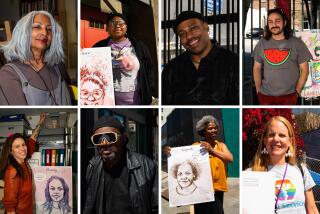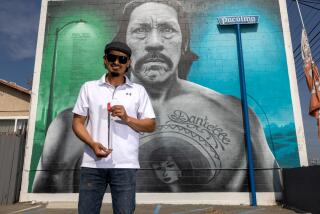‘Three Weeks’ of rapes, 35 years later
Standing outside the Los Angeles Police Department’s headquarters earlier this week, Suzanne Lacy had a camera around her neck and a red marker in hand. The artist had taped two printouts of the word “rape” onto one section of a 28-foot-long map of Los Angeles and was puzzling over the question. How big should the letters in “rape” be?
Lacy was getting ready to launch a multifaceted anti-rape project called “Three Weeks in January,” after her influential 1977 project, “Three Weeks in May,” for which she installed a map of L.A. in a downtown mall. Every morning for three weeks, Lacy received a report from the police department with data on the previous day’s rapes. She then stenciled the word “rape” in deep red on the map, in the area where the crime occurred, adding fainter stamps around it to symbolize unreported rapes.
This month she is making a new rape map, installed outside the LAPD’s Deaton Auditorium, as the centerpiece of a new anti-violence campaign. In collaboration with such groups as Peace Over Violence and Code Pink, she has organized about 40 rape-awareness performances, conversations and other events taking place this month under the “Three Weeks” umbrella, from a news conference with Mayor Antonio Villaraigosa to a candlelight vigil at the police headquarters.
But first Lacy had to choose the right size letters. “We’re trying to figure out how this might play out visually,” she said, using the marker to enlarge the letters on one printout. “It’s hard to tell in advance if this is too big, not knowing how many rapes will occur in this period in each neighborhood.”
She consulted nearly a dozen people, including police officers walking by, before choosing the smaller of the two sizes. “I care about the look of these things more than anybody would realize; I believe in that level of attention to detail,” she said. “It’s not a strategy -- more recognizing that people are moved by visually powerful phenomena. We have a spiritual or emotional connection to aesthetics that we aren’t even aware of.”
Hearing most artists talk about the power of images would not be unusual, but Lacy is known for being an issues-oriented sort of conceptual artist who is not beholden to beauty. As a pioneering feminist artist, she helped develop the type of art known as “social practice” or “public practice,” both through her own artmaking and her teaching. She now leads a graduate program in the field at Otis College of Art and Design.
The idea is that socially engaged or politically committed artists can use the attention-getting power of art to reach the public and press alike and try to create change. The challenge is to blend art and activism in forms that work on both levels.
Over the years Lacy has helped to mobilize and provide creative outlets for teenagers in Oakland, housewives in Korea and Minnesota senior citizens, often operating like a community organizer with one foot in the art world. And she has done several projects dealing directly with sexual violence, going back to “Three Weeks in May,” inspired by the frequency of rapes in L.A. in the 1970s.
Lacy says L.A. was then called “the rape capital of the world.” According to the LAPD, there were 2,387 sex crimes reported in the city in 1977 compared with 947 sex crimes last year, and reporting rates have substantially increased.
But knowing that awareness of rape is up, and its incidence is down, why revisit this project?
Lacy acknowledges that the social context has dramatically changed since 1977, noting progress in rape prevention and treatment. But she says that sexual violence remains a problem. “We have this unfortunate habit in this country of thinking that when you’ve seen something and it’s become a topic of conversation, it’s over. The real issues of violence against women aren’t over,” she said. “This is one of the most, if not the most, underreported of all crimes, and one big question is how much is going on in high schools and college campuses without being reported.”
LAPD Det. Monica Quijano agreed: “We have made incredible advancements in training for front-line personnel, advocacy for victims, and the ways the cases are handled. But we still have a lot of work to do,” Quijano said, adding that only one out of every three rapes is reported.
Lacy, who says she believes but cannot prove that the percentage of unreported rapes is actually much higher, gave another reason for revisiting the project this year. The organizers of the cultural extravaganza Pacific Standard Time asked her to participate in their performance art festival, which officially starts Thursday, by suggesting she reprise a ritualistic performance about the Hillside Strangler. She found the topics in the rape project more urgent and relevant, and the alternative gallery LACE signed on to produce it.
“Projects like this really push the public imagination in seeing where art can happen and who can make it happen,” said Carol Stakenas, the director of LACE. “Suzanne is the visionary behind this, but there are so many people who can participate, from the mayor at the press conference to people walking by on the street.”
She also credits Lacy, whom she describes as rigorous in her approach to collaborations, with bringing her ideas to life in compelling forms. “Today, with the nature of what’s online like Google maps, data visualization is part of everyday life. But in the 1970s the mapping strategy she used with the rape map was groundbreaking.”
This time around, the “Three Weeks” project uses the Internet. Lacy is now receiving the rape reports every morning from police officers by email, not in person. The project has a Facebook page and website ( www.threeweeksinjanuary .org) to help visitors navigate the events taking place. And she has started a Twitter campaign (“I know someone, do you?”) to help get the word out.
Her Otis students urged her to use Twitter. “My students said right away that I need to do social media,” Lacy said. “I asked, and still wonder: Do you really think this is going to be meaningful to women and men who have been raped? Isn’t it more comforting to share your experience with someone in the same room?”
The Twitter campaign is one example of how Lacy allowed input from a network of partners and collaborators. She is also forging alliances to ensure that her work -- and this network of relationships itself, which she sees as a goal as well as a means for her project -- does not vanish when the three weeks wind up.
She has worked with Patti Giggans, the director of Peace Over Violence, to create templates for women who want to organize discussions on violence in their lives and communities, designed to feed one of Giggans’ research projects. And Lacy plans to turn her project infrastructure over to the L.A. supporters of the One Billion Women initiative, a worldwide “peace-making” campaign that began with six women who have won Nobel peace prizes.
“We’re going to give them the legacy of the project -- the project’s assets, its website, its Twitter following, its volunteer bank,” Lacy said.
Still, the component most likely to survive into the future is the rape map itself, much as the original rape map from 1977 is the most prominent artifact from the earlier project. That map is now on display at the Geffen Contemporary downtown, just a few blocks from LAPD headquarters, as part of a group exhibition of political art from the 1970s. Although it has become a sort of fossil record of art that strove for activism, it has not lost its punch.
--
More to Read
The biggest entertainment stories
Get our big stories about Hollywood, film, television, music, arts, culture and more right in your inbox as soon as they publish.
You may occasionally receive promotional content from the Los Angeles Times.










